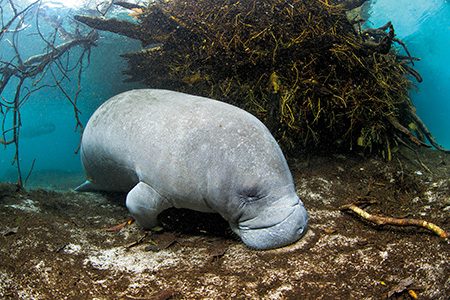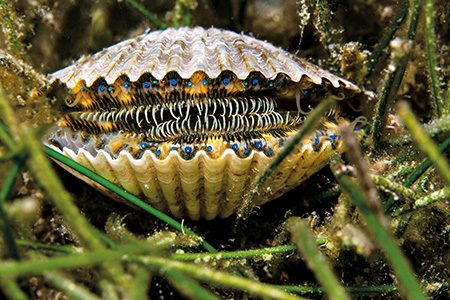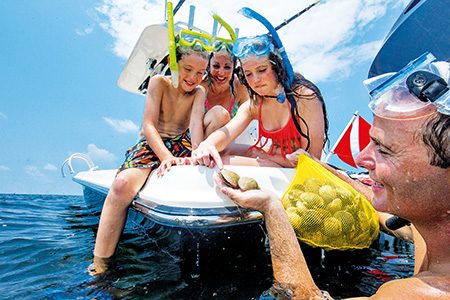Sometimes the tiniest critters can pack the greatest punch. Phytoplankton, which are unicellular microalgae, can cause mass mortalities of animals such as dolphins and manatees and be the source of serious human illness.
What are phytoplankton?
Plankton are drifters; unable to move against the current, they drift along with the water’s movement. The most abundant form of life in the ocean, plankton are split into two broad categories: zooplankton and phytoplankton.
Zooplankton are consumers that range in size from microscopic rotifers to macroscopic jellyfish. Phytoplankton, however, are microscopic and photosynthetic, so they depend on the sun. There are two main classes of phytoplankton: diatoms, which usually connect and form long chains, and dinoflagellates, which have flagella — threadlike appendages used for motility.


How does a unicellular organism cause mass mortality?
Of the thousands of species of phytoplankton, only a few dozen produce toxins. Toxic phytoplankton generally have little negative impact on a healthy ecosystem, but when environmental conditions change to support phytoplankton growth, the microalgae can rapidly multiply. This bloom can negatively impact other animals and the ecosystem overall; this phenomenon is called a harmful algal bloom (HAB).
While phytoplankton are at the base of the food chain, animals higher on the food web are generally the most impacted during HABs due to biomagnification, which is the process by which toxins pass from one trophic level to the next, increasing in concentration. Higher-level organisms — such as fish, seabirds, manatees, sea lions, turtles, and dolphins — tend to be the most affected.
Last year, for example, there was a mass stranding of marine mammals in Southern California due to an HAB that particularly impacted sea lions. Elevated phytoplankton levels of the genus Pseudo-nitzschia caused their toxin, domoic acid, to accumulate in small fish, such as sardines and anchovies, that feed on plankton. When sea lions eat the fish, the toxin enters their bloodstream and can damage their brains, causing seizures, tremors, and disorientation. In severe cases, domoic acid poisoning can be fatal.
The East Coast is no stranger to the impacts of HABs either. According to the Florida Fish and Wildlife Conservation Commission, 20% of manatee mortalities in 2023 were attributed to HABs. Karenia brevis, a phytoplankton known as the “red tide organism” because it discolors the water when in high concentrations, can impact the local wildlife. Signs that a manatee has been affected by high concentrations of the toxin include difficulty swimming, disorientation, and seizures. Along with watercraft collisions, which account for an average of 20% to 25% of annual manatee mortalities, researchers believe HABs will be the leading cause of manatee deaths in the long term.
Since fall 2023, abnormal fish behavior events, such as spinning, have occurred in the Florida Keys. There have been associated small-scale fish mortalities, including the endangered smalltooth sawfish. While the cause of the abnormal behavior and fish mortalities is unknown, elevated levels of toxic phytoplanktonfound in some areas are a possible source.


How do toxic phytoplankton cause human illness?
Toxins can affect humans who consume fish or shellfish that have accumulated the toxins. Ciguatera fish poisoning, the most frequently reported seafood-related disease worldwide, results from toxins originating in Gambierdiscus, a phytoplankton found in tropical regions throughout the world. It most commonly accumulates in large reef fish, such as barracudas, groupers, and snappers. The first symptom is often cold allodynia, which is when cold objects induce a burning sensation.
The brevetoxins affecting the manatees in Florida can also cause neurotoxic shellfish poisoning in humans who consume contaminated shellfish. Molluscan shellfish such as oysters, clams, and mussels are filter feeders that get nutrients from small organisms such as bacteria and microalgae. Brevetoxin accumulates in these filter feeders when its levels are high, leaving a human who eats the shellfish susceptible to contamination. The initial symptoms are generally gastrointestinal accompanied by numbness or tingling around the mouth and extremities.
Brevetoxin can also be aerosolized, so toxicity can also result from inhalation. Walking on a beach where the coastal waters are experiencing a red tide event can cause respiratory irritation, which can be quite severe for those who have asthma or similar ailments.
Other human illnesses that result from consuming shellfish that have accumulated various phytoplankton-produced toxins include amnesic shellfish poisoning (which results from domoic acid, the toxin that affected the sea lions in Southern California), diarrhetic shellfish poisoning, and paralytic shellfish poisoning (PSP). PSP is the most common and severe of these illnesses, and it can cause death, particularly in children.
Minimizing exposure to these toxins is not as simple as it sounds. You can’t detect the toxins in seafood by appearance or taste, and neither freezing nor cooking will destroy the toxins. Do not eat locally collected seafood in areas with an HAB. Most areas monitor HABs and adjust commercial fishing regulations accordingly. To prevent ciguatera poisoning, avoid eating higher-level reef fish known to accumulate the toxin or large amounts of any reef fish, and follow local knowledge as toxins may accumulate at specific reef sites.
What are the benefits of phytoplankton?
Healthy phytoplankton populations are essential for healthy aquatic ecosystems and for humans. Phytoplankton are the base of the food chain and an important food source.
Phytoplankton also play a significant role in the global carbon cycle. During photosynthesis, phytoplankton use carbon dioxide and release oxygen to the water and atmosphere. Phytoplankton emit about 50% of the oxygen they produce into the atmosphere. Removing carbon dioxide, a greenhouse gas, is equally important. When plankton die, they sink to the bottom of the ocean, taking the carbon with them and creating a carbon sink.
While HABs occur naturally, human activity influences them. Warm, nutrient-rich waters fuel algal blooms, and we see more HABs now than in the past. Climate change will likely continue to affect their magnitude and severity.
Explore More
Learn more about phytoplankton in this video.
© Alert Diver – Q3 2024

